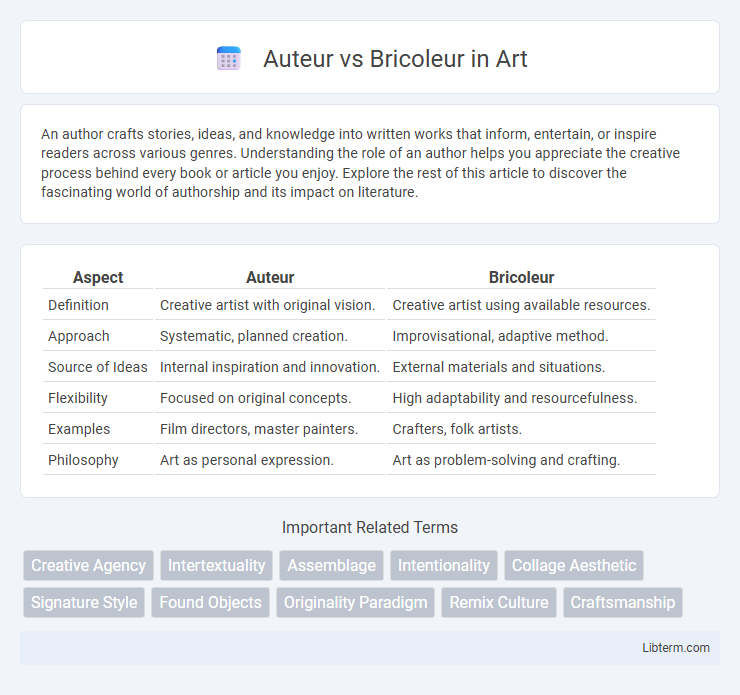An author crafts stories, ideas, and knowledge into written works that inform, entertain, or inspire readers across various genres. Understanding the role of an author helps you appreciate the creative process behind every book or article you enjoy. Explore the rest of this article to discover the fascinating world of authorship and its impact on literature.
Table of Comparison
| Aspect | Auteur | Bricoleur |
|---|---|---|
| Definition | Creative artist with original vision. | Creative artist using available resources. |
| Approach | Systematic, planned creation. | Improvisational, adaptive method. |
| Source of Ideas | Internal inspiration and innovation. | External materials and situations. |
| Flexibility | Focused on original concepts. | High adaptability and resourcefulness. |
| Examples | Film directors, master painters. | Crafters, folk artists. |
| Philosophy | Art as personal expression. | Art as problem-solving and crafting. |
Defining the Auteur: Vision and Control
The auteur is defined by their visionary approach and authoritative control over the creative process, shaping every element of the film to reflect their personal style and thematic concerns. This concept emphasizes the director's role as the primary author, guiding narrative structure, visual design, and character development to achieve a cohesive artistic vision. Auteur theory highlights directors like Alfred Hitchcock and Stanley Kubrick, whose distinctive techniques exemplify creative dominance and consistent thematic exploration.
The Essence of the Bricoleur: Creativity from Constraints
The essence of the bricoleur lies in resourceful creativity, utilizing available materials and tools to solve problems within constraints. Unlike the auteur who imposes a singular vision, the bricoleur thrives by repurposing and adapting resources in innovative ways. This adaptive bricolage fosters original solutions derived directly from the limitations and opportunities presented by the environment.
Historical Origins of Auteur Theory
The Auteur Theory originated in the 1940s and 1950s within French film criticism, particularly promoted by critics of Cahiers du Cinema such as Francois Truffaut and Andre Bazin. This theory emphasized the director as the primary creative force behind a film, asserting that a director's personal vision and style render a film an artistic expression akin to an author's work in literature. The historical context arose as a response to studio-driven production lines, championing directors who imbued their films with distinctive thematic and stylistic trademarks.
Bricoleur Practices Across Creative Fields
Bricoleur practices manifest across creative fields through resourceful adaptation and inventive use of available materials, emphasizing improvisation and bricolage techniques. In disciplines like film, art, and design, bricoleurs repurpose diverse tools and ideas, fostering originality without reliance on traditional expertise or extensive resources. This approach not only challenges conventional production methods but also nurtures innovation by blending disparate elements into cohesive, novel outputs.
Auteur Approach in Modern Filmmaking
The auteur approach in modern filmmaking emphasizes the director as the primary creative force shaping a film's vision, style, and narrative coherence. Directors like Christopher Nolan and Quentin Tarantino exemplify this by imprinting distinct thematic concerns and visual signatures that resonate throughout their work. This approach fosters a deeply personal cinematic experience, often prioritizing artistic expression over commercial considerations.
Bricoleur Methods in Digital Innovation
Bricoleur methods in digital innovation emphasize resourcefulness by repurposing existing technologies and tools to create novel solutions without relying on formal planning or design processes. This approach leverages improvisation and iterative experimentation, enabling rapid adaptation to emerging digital trends and constraints. As a result, bricoleurs drive innovation through flexible, hands-on problem solving, often leading to unexpected and organic technological advancements.
Comparative Analysis: Strengths and Weaknesses
Auteur theory emphasizes a director's unified vision and creative control, producing cohesive, stylistically consistent films that showcase artistic intent. Bricoleur methodology highlights adaptability by repurposing existing resources, fostering innovative problem-solving and practical creativity in diverse production contexts. While auteur-driven projects benefit from artistic distinctiveness, they may lack flexibility; bricoleur approaches excel in resourcefulness but can lead to less stylistic coherence.
Collaboration vs. Individual Vision
The Auteur approach emphasizes a singular creative vision, positioning the artist as the primary driver of a work's meaning, often leading to a cohesive but individualistic output. In contrast, the Bricoleur embraces collaborative processes, integrating diverse inputs and adapting existing materials to create multifaceted and contextually rich projects. This dynamic between Auteur and Bricoleur highlights the tension between maintaining individual control and fostering collaborative innovation within artistic and creative fields.
Impact on Audience Perception
Auteur filmmakers shape audience perception by asserting a distinctive creative vision, leading viewers to recognize and anticipate unique storytelling styles and thematic consistencies. Bricoleurs influence perception through adaptive creativity, assembling diverse elements that generate innovation and unpredictability, which invites the audience to engage with films in a more exploratory manner. The contrast between the auteur's deliberate authorship and the bricoleur's improvisational approach significantly affects how viewers interpret and connect with cinematic works.
Future Trends: Blending Auteur and Bricoleur Styles
Future trends in creative industries reveal a seamless blending of Auteur and Bricoleur styles, where visionary directors incorporate hands-on bricolage techniques to innovate storytelling. This hybrid approach leverages Auteur's distinct creative control with Bricoleur's resourceful adaptability, enhancing narrative depth and production flexibility. Emerging technologies like AI-driven tools and modular media platforms further facilitate this convergence, enabling creators to fuse personal artistic vision with multisource contributions efficiently.
Auteur Infographic

 libterm.com
libterm.com